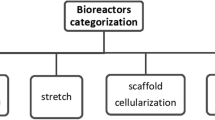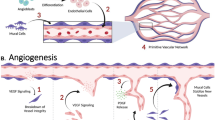Abstract
In vitro tissue engineering of vascular grafts requires dynamic conditioning in a bioreactor system for in vitro tissue maturation and remodeling to receive a mechanically adequate and hemocompatible implant. The goal of the current work was to develop a bioreactor system for the conditioning of vascular grafts which is (i) able to create a wide range of flow, pressure and frequency conditions, including physiological ones; (ii) compact and easy to assemble; (iii) transportable; (iv) disposable. The system is driven by a small centrifugal pump controlled via a custom-made control unit, which can also be operated on batteries to allow for autonomous transportation. To show the potential of the newly developed bioreactor system small-caliber vascular composite grafts (n = 5, internal diameter = 3 mm, length = 12.5 cm) were fabricated using a fibrin scaffold embedding human umbilical artery smooth muscle cells and a polyvinylidene fluoride warp-knitted macroporous mesh. Subsequently, the vascular grafts were endothelialized and mounted in the bioreactor system for conditioning. The conditioning parameters remained within the predefined range over the complete conditioning period and during operation on batteries as tested for up to 25 h. Fabrication and pre-conditioning under arterial pressure and shear stress conditions resulted in robust and hemocompatible tissue-engineered vascular grafts. Analysis of immunohistochemical stainings against extracellular matrix and cell-specific proteins revealed collagen I and collagen III deposition. The luminal surface was confluently covered with endothelial cells. The developed bioreactor system showed cytocompatibility and pH, pO2, pCO2, glucose and lactate stayed constant. Sterility was maintained during the complete fabrication process of the vascular grafts. The potential of a versatile and mobile system and its functionality by conditioning tissue-engineered vascular grafts under physiological pressure and flow conditions could be demonstrated.





Similar content being viewed by others
References
Boyle, E. M., T. G. Canty, E. N. Morgan, W. Yun, T. H. Pohlman, and E. D. Verrier. Treating myocardial ischemia-reperfusion injury by targeting endothelial cell transcription. Ann. Thorac. Surg. 68:1949–1953, 1999.
Boyle, E. M., T. H. Pohlman, C. J. Cornejo, and E. D. Verrier. Endothelial cell injury in cardiovascular surgery: ischemia-reperfusion. Ann. Thorac. Surg. 62:1868–1875, 1996.
Carden, D. L., and D. N. Granger. Pathophysiology of ischemia-reperfusion injury. J. Pathol. 190:255–266, 2000.
Cardinal, K. O. H., G. T. Bonnema, H. Hofer, J. K. Barton, D. Ph, S. K. Williams, and D. Ph. Tissue-engineered vascular grafts as in vitro blood vessel mimics for the evaluation of endothelialization of intravascular devices. Tissue Eng. 12:3431–3438, 2006.
Diamantouros, S. E., L. G. Hurtado-Aguilar, T. Schmitz-Rode, P. Mela, and S. Jockenhoevel. Pulsatile perfusion bioreactor system for durability testing and compliance estimation of tissue engineered vascular grafts. Ann. Biomed. Eng. 41:1979–1989, 2013.
Gong, X., H. Liu, X. Ding, M. Liu, X. Li, L. Zheng, X. Jia, G. Zhou, Y. Zou, J. Li, X. Huang, and Y. Fan. Physiological pulsatile flow culture conditions to generate functional endothelium on a sulfated silk fibroin nanofibrous scaffold. Biomaterials 35:4782–4791, 2014.
Gui, L., M. J. Boyle, Y. M. Kamin, A. H. Huang, B. C. Starcher, C. A. Miller, M. J. Vishnevetsky, and L. E. Niklason. Construction of tissue-engineered small-diameter vascular grafts in fibrin scaffolds in 30 days. Tissue Eng. Part A 20:1499–1507, 2014.
Hahn, M. S., M. K. McHale, E. Wang, R. H. Schmedlen, and J. L. West. Physiologic pulsatile flow bioreactor conditioning of poly(ethylene glycol)-based tissue engineered vascular grafts. Ann. Biomed. Eng. 35:190–200, 2007.
Hibino, N., E. McGillicuddy, G. Matsumura, Y. Ichihara, Y. Naito, C. Breuer, and T. Shinoka. Late-term results of tissue-engineered vascular grafts in humans. J. Thorac. Cardiovasc. Surg. 139:431–436.e2, 2010.
Huang, A. H., Y.-U. Lee, E. A. Calle, M. Boyle, B. C. Starcher, J. D. Humphrey, and L. E. Niklason. Design and use of a novel bioreactor for regeneration of biaxially stretched tissue-engineered vessels. Tissue Eng. Part C Methods 21:841–851, 2015.
Isenberg, B. C., C. Williams, and R. T. Tranquillo. Endothelialization and flow conditioning of fibrin-based media-equivalents. Ann. Biomed. Eng. 34:971–985, 2006.
Iwasaki, K., K. Kojima, S. Kodama, A. C. Paz, M. Chambers, M. Umezu, and C. A. Vacanti. Bioengineered three-layered robust and elastic artery using hemodynamically-equivalent pulsatile bioreactor. Circulation 118:S52–S57, 2008.
Koch, S., T. C. Flanagan, J. S. Sachweh, F. Tanios, H. Schnoering, T. Deichmann, V. Ellä, M. Kellomäki, N. Gronloh, T. Gries, R. Tolba, T. Schmitz-Rode, and S. Jockenhoevel. Fibrin-polylactide-based tissue-engineered vascular graft in the arterial circulation. Biomaterials 31:4731–4739, 2010.
Konig, G., T. N. McAllister, N. Dusserre, S. A. Garrido, C. Iyican, A. Marini, A. Fiorillo, H. Avila, W. Wystrychowski, K. Zagalski, M. Maruszewski, A. L. Jones, L. Cierpka, L. M. de la Fuente, and N. L’Heureux. Mechanical properties of completely autologous human tissue engineered blood vessels compared to human saphenous vein and mammary artery. Biomaterials 30:1542–1550, 2009.
Koo, D. D. H., K. I. Welsh, N. E. J. West, K. M. Channon, A. J. Penington, J. A. Roake, P. J. Morris, and S. V. Fuggle. Endothelial cell protection against ischemia/reperfusion injury by lecithinized superoxide dismutase. Kidney Int. 60:786–796, 2001.
L’Heureux, N., T. McAllister, and L. de la Fuente. Tissue-engineered blood vessel for adult arterial revascularization. N. Engl. J. Med. 357:1451–1453, 2007.
Lawson, J. H., M. H. Glickman, M. Ilzecki, T. Jakimowicz, A. Jaroszynski, E. K. Peden, A. J. Pilgrim, H. L. Prichard, M. Guziewicz, S. Przywara, J. Szmidt, J. Turek, W. Witkiewicz, N. Zapotoczny, T. Zubilewicz, and L. E. Niklason. Bioengineered human acellular vessels for dialysis access in patients with end-stage renal disease: two phase 2 single-arm trials. Lancet 387:2026–2034, 2016.
Manevich, Y., A. B. U. Al-mehdi, V. Muzykantov, A. B. Fisher, A. Al-mehdi, V. Muzykan-, A. B. Fisher, A. J. Physiol, H. Circ, and H. Physiol. Oxidative burst and NO generation as initial response to ischemia in flow-adapted endothelial cells. Am. J. Physiol. Heart Circ. Physiol. 280:2126–2135, 2001.
Martin, I., D. Wendt, and M. Heberer. The role of bioreactors in tissue engineering. Trends Biotechnol. 22:80–86, 2004.
McCulloch, A. D., A. B. Harris, C. E. Sarraf, and M. Eastwood. New multi-cue bioreactor for tissue engineering of tubular cardiovascular samples under physiological conditions. Tissue Eng. 10:565–573, 2004.
Mertens, M. E., S. Koch, P. Schuster, J. Wehner, Z. Wu, F. Gremse, V. Schulz, L. Rongen, F. Wolf, J. Frese, V. N. Gesché, M. van Zandvoort, P. Mela, S. Jockenhoevel, F. Kiessling, and T. Lammers. USPIO-labeled textile materials for non-invasive MR imaging of tissue-engineered vascular grafts. Biomaterials 39:155–163, 2015.
Mold, C., and C. A. Morris. Complement activation by apoptotic endothelial cells following hypoxia/reoxygenation. Immunology 102:359–364, 2001.
Olausson, M., P. B. Patil, V. K. Kuna, P. Chougule, N. Hernandez, K. Methe, C. Kullberg-lindh, and H. Borg. Transplantation of an allogeneic vein bioengineered with autologous stem cells: a proof-of-concept study. Lancet 380:230–237, 2012.
Pashneh-Tala, S., S. MacNeil, and F. Claeyssens. The tissue-engineered vascular graft—past, present, and future. Tissue Eng. Part B Rev. 22:68–100, 2016.
Song, L., Q. Zhou, P. Duan, P. Guo, D. Li, Y. Xu, S. Li, F. Luo, and Z. Zhang. Successful development of small diameter tissue-engineering vascular vessels by our novel integrally designed pulsatile perfusion-based bioreactor. PLoS One 7:e42569, 2012.
Syedain, Z. H., L. A. Meier, J. W. Bjork, A. Lee, and R. T. Tranquillo. Implantable arterial grafts from human fi broblasts and fibrin using a multi-graft pulsed flow-stretch bioreactor with noninvasive strength monitoring. Biomaterials 32:714–722, 2011.
Udelsman, B. V., M. W. Maxfield, and C. K. Breuer. Tissue engineering of blood vessels in cardiovascular disease: moving towards clinical translation. Heart 99:454–460, 2013.
Uzarski, J. S., J. Cores, and P. S. McFetridge. Physiologically modeled pulse dynamics to improve function in in vitro-endothelialized small-diameter vascular grafts. Tissue Eng. Part C Methods 21:1125–1134, 2015.
Uzarski, J. S., E. W. Scott, and P. S. McFetridge. Adaptation of endothelial cells to physiologically-modeled, variable shear stress. PLoS One 8:17–19, 2013.
Wei, Z., K. Costa, A. B. Al-Mehdi, C. Dodia, V. Muzykantov, and A. B. Fisher. Simulated ischemia in flow-adapted endothelial cells leads to generation of reactive oxygen species and cell signaling. Circ. Res. 85:682–689, 1999.
Wendt, D., and S. A. Riboldi. Bioreactors in tissue engineering: from basic research to automated product manufacturing. In: Fundamentals of Tissue Engineering and Regenerative Medicine. 2009, pp. 595–611. https://doi.org/10.1007/978-3-540-77755-7_42.
Wendt, D., S. A. Riboldi, M. Cioffi, and I. Martin. Potential and bottlenecks of bioreactors in 3D cell culture and tissue manufacturing. Adv. Mater. 21:3352–3367, 2009.
Wilhelmi, M., S. Jockenhoevel, and P. Mela. Bioartificial fabrication of regenerating blood vessel substitutes: requirements and current strategies. Biomed. Eng. 59:185–195, 2014.
Williams, C., and T. M. Wick. Perfusion bioreactor for small diameter tissue-engineered arteries. Tissue Eng. 10:930–941, 2004.
Yang, Q., G. W. He, M. J. Underwood, and C. M. Yu. Cellular and molecular mechanisms of endothelial ischemia/reperfusion injury: perspectives and implications for postischemic myocardial protection. Am. J. Transl. Res. 8:765–777, 2016.
Yazdani, S. K., B. W. Tillman, J. L. Berry, S. Soker, and R. L. Geary. The fate of an endothelium layer after preconditioning. J. Vasc. Surg. 51:174–183, 2010.
Acknowledgments
Funded by the Excellence Initiative of the German federal and state governments in the framework of the i3tm Seed Fund projects (Funding Number: SF_16-6-01) and Step2Projects. We thank Dennis Faßbaender, Institute of Applied Medical Engineering, for his valuable contributions to the development of the pump controller.
Conflict of interest
The authors declare that no competing financial or other interests have influenced this study. None of the authors is financially affiliated with any of the companies mentioned.
Author information
Authors and Affiliations
Corresponding author
Additional information
Associate Editor Peter E. McHugh oversaw the review of this article.
Electronic supplementary material
Below is the link to the electronic supplementary material.
Rights and permissions
About this article
Cite this article
Wolf, F., Rojas González, D.M., Steinseifer, U. et al. VascuTrainer: A Mobile and Disposable Bioreactor System for the Conditioning of Tissue-Engineered Vascular Grafts. Ann Biomed Eng 46, 616–626 (2018). https://doi.org/10.1007/s10439-018-1977-y
Received:
Accepted:
Published:
Issue Date:
DOI: https://doi.org/10.1007/s10439-018-1977-y




